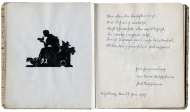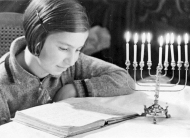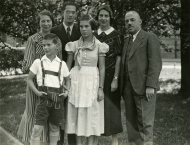|
|
|
|
|
|
|
|
|
|
|
|
|
|
|
|
|
|
|
|
|
|
|
|
|
|
|
|
|
|
|
|
|
|
|
|
|
|
|
|
|
|
|
|
|
|
|
|
|
|
|
|
|
|
|
|
|
|
|
|
|
|
|
|
|||||||||||||||||||||||||||
|
|
Gertrud Farnbacher Born: 1919. Father’s occupation: businessman. Flat: 31 Hochfeldstraße, Augsburg. Shop: 11 Hermanstraße. Gertrud’s father, Fritz Farnbacher (b. 1885), was co-owner of a business for haberdashery, fancies and toys (“Wernecker & Farnbacher”). Her mother was Frieda, née Reis (b. 1895 in Munich). Gertrud attended Maria-Theresia-School from 1930 to 1936 in classes 1–3 and G4–G6. In 1935, Gertrud celebrated her “confirmation” in Augsburg, together with some other Jewish girls (Bat Mitzvah: the feast of religious maturity for Jewish girls; it can be celebrated individually on the Sabbath after a girl’s 12th birthday, but in Augsburg it was held annually or after even longer intervals for several age groups together, similar to the Protestant confirmation). After leaving Maria-Theresia-School, Getrud studied English, French and home economics in Switzerland. After short stays in Berlin and again in Augsburg, she emigrated to England in March 1939, where she changed her forename to Karen. Her two brothers only just succeeded in emigrating to England in the same year. However, Ernst committed suicide in 1942, at the age of 18; Rudi followed him in 1947, being 23 years old. Gertrud studied at the London School of Economics, went to the USA in 1951 and married in 1955; since then her name is Karen G. Hillman. She earned a Master’s Degree in Sociology, but after an accident in 1961, was forced to end her scientific career. However, she published some scientific articles. Karen G. Hillman, née Gertrud Farnbacher, lives to this day in the USA (2007). Together with many other Jewish girls and women, Gertrud’s mother Frieda had to do forced labour in the Augsburg balloon factory from February 1942 to the beginning of March 1943 when both parents were deported to Auschwitz. |
|
|
Herta Fichtelberger Born: 1912 in Augsburg. Father’s occupation: businessman. Flat: 12 Frölichstraße. Herta’s father, Ferdinand Fichtelberger (b. 1871 in Ermershausen), was co-partner of the “United Linen Factory, Friedmann & Dannenbaum / Lammfromm & Biedermann” and manager of the “Linen Factory AG”. His wife was Hannchen, née Fichtelberger (b. 1873 in Hersbruck). Herta had a younger brother, Wilhelm (b. 1914). Herta attended Maria-Theresia-School from 1924 to 1928 in classes 3–6; presumably, she had joined the school in class 1 in 1922. Herta emigrated to the USA in 1938, as well as her brother Wilhelm, who fought in the US Army during the war. In 1942, Herta married Albert Rowen in Los Angeles. The married couple had two sons. Herta Rowen, née Fichtelberger, died in Los Angeles between 1976 and 1985. Herta’s parents were deported to Terezin in August 1942. Ferdinand died there on November 14, 1942. Hannchen was deported to Auschwitz in May 1944. Sources: Yad Vashem, “Pages of Testimony” filled out by Herta Rowen in memory of her parents in 1976. A note by Margot Bloch-Stein on Herta Rowen’s death, referred to by Gernot Römer: G. Römer, ed., “An meine Gemeinde in der Zerstreuung.” Die Rundbriefe des Augsburger Rabbiners Ernst Jacob 1941–1949, Augsburg, 2007, p. 338. |
|
Edith Fleischmann Born: 1924. Father’s occupation: merchant. Edith’s father, Wilhelm Fleischmann (1900–1951), came from Czechoslovakia (?). Her mother, Ruth, née Baer (1901–85), was born in Künzelsau. Wilhelm was a merchant in Augsburg but also was selling pianos in Ulm for one or two years. Edith had a younger brother, Alfred (1925–98). Edith attended Maria-Theresia-School from 1935 to 1937 in classes 1–3. 13-year-old Edith dropped out of the school on September 15, 1937, during the school year. The whole family emigrated to Pittsburgh, Pennsylvania. Edith attended the University of Pittsburgh. In 1947, she married Warren S. Bloch. Edith took an active part in Warren’s CPA practice. They had three children. Edith Bloch, née Fleischmann, died in 1975. (This brief biography is based on an e-mail message which Edith’s husband, Warren S. Bloch, sent to the project group in July 2007.) |
|
Martha Fleischmann Born: 1903 in Munich. Father’s occupation: businessman. Martha’s father was Josef Fleischmann (b. 1867 in Bratislava), her mother was called Josefa. Martha attended Maria-Theresia-School from 1914 to 1917 in classes 1–3 and perhaps also in the following year, 1917/18. Martha resigned from the Jewish community in 1934, but re-entered again in 1940. She did—as well as many other Jewish girls and women—forced labour in the Augsburg balloon factory. In 1942, her father committed suicide. On April 13, 1943, Martha was deported to Terezin via Munich; in September, she was sent to Auschwitz and is listed as missing. Martha Fleischmann’s name is listed on a glass plaque of the shoah memorial that can be visited in Augsburg’s City Hall (artist: Klaus Goth). |
Theri Fleischmann Born: 1922 in Augsburg (no place of birth is given in the Annual School Report). Father’s occupation: businessman. Theri attended Maria-Theresia-School only for a short time, in Spring and Summer 1932 in class 1. 10-year-old Theri dropped out of the school on July 15, 1932, only a few months after school had begun. For a while she lived in Hamburg. She was deported to Piaski, Poland, at the beginning of April 1942. For two months, from April to June 1942, the engineer Arnold Hindls from Brno, Moravia, also lived in Piaski. For him this was but one of many deportation stations, between Terezin and Ossovo. In his memoirs, One Man Returned, published in Germany in 1965, he tells about Piaski: “Piaski is a small town in the Lublin district, surrounded by sand, swamps, and forests. The state road from Lublin to Chelm divides it into two parts. Therefore, the Jewish ghetto, which once was very large and inhabited by approx. 3000 local Jews, extended on both sides of the state road. Now, however, these two parts of the ghetto were each enclosed by high fences made of boards and barbed wire. They had big gates, which were permanently guarded and opened only twice a day, for one hour in the morning and one in the afternoon. The gates were closed towards the state road. ... |
|
|
Hedwig Frank Born: 1893 in Augsburg. Father’s occupation: butcher. Address: 14 Dominikanergasse. Hedwig’s father, Adolf Frank (b. 1864 in Bütthard), slaughtered for the Jewish community according to its strict dietary laws. Hedwig’s mother was Laura, former married name Herzog, née Lemle (b. 1862). From the first marriage of her mother, Hedwig had an older half sister, Bella, née Herzog (b. 1884). From her mother’s second marriage, Hedwig had three siblings; one of them, her sister Rosa (b. 1897), attended Maria-Theresia-School as did Hedwig. The other two were Ida Jette (b. 1892) and Arthur (b. 1900). Two other siblings had died when they were little children. Hedwig was a cousin of Rosa Frank (b. 1898) and of Herta Frank. Hedwig attended the “Municipal School for Daughters” (“Städtische Töchterschule”), which later was to be called “Maria-Theresia-School”, from 1904 to 1907 in classes 1–3. In 1920, Hedwig married Alexander Wormser (b. 1893). He was Chief Clerk and Division Chief at the “Dresdner Bank” in Augsburg. He was discharged under the National Socialist regime and in November 1938 brought to the Dachau concentration camp for some time. As her sister Rosa before her, Hedwig emigrated with her husband and their two daughters (b. 1921 and 1922) to Buffalo, New York, in 1939. Hedwig Wormser, née Frank, died in 1980 in Amarillo, Texas. One of Hedwig’s daughters married Eric Teutsch, a brother of Ruth Teutsch, in 1948. Hedwig’s father died in Augsburg in 1930. The widowed Laura Frank moved to Munich in 1939 and was deported to Terezin in June 1942; three months later she was killed in Treblinka. |
|
Herta Frank Born: 1895 in Augsburg. Father’s occupation: livestock dealer. Herta’s parents were Leopold Frank (b. 1868 in Bütthard) and Barbara, née Schimmel (b. 1871 in Steppach, near Augsburg). Herta’s younger sister, Rosa (b. 1898), attended the “Municipal School for Daughters” (“Städtische Töchterschule”), which later was to be called “Maria-Theresia-School”, as did Herta. Herta was a cousin of Hedwig Frank and of Rosa Frank (b. 1897). Herta attended the “Töchterschule” for only one year, 1906/07, in class 1. In January 1907, Herta’s parents got divorced. Herta’s father, Leopold Frank, died in 1911. In 1921, Herta married the Legal Assistant Joseph Ullrich. Her mother died in Augsburg in 1923. Herta’s brother Siegfried (1902–1955) emigrated to France in 1933. Herta’s brother Ludwig (1900–1983) worked in Augsburg as an accountant of the firm “Wernecker & Farnbacher”. In 1939, he moved to his brother, Siegfried, who lived with his family in Lyon, France. In September 1942, Ludwig tried in vain to flee to Switzerland. He was deported to Auschwitz. There he worked in an office and survived his imprisonment in the camp. Aside: According to a document (“Familien-Bogen”) preserved at the Augsburg City Archives, Leopold’s first daughter was not called Herta, but Herda. |
|
|
|
Hertha Frank Born: 1925 in Augsburg (no place of birth is given in the Annual School Reports). Father’s occupation: businessman. Flat: D 279 Philippine-Welser-Straße. Hertha’s mother, Fanny (Franziska) Frank, née Mendelsohn, attended Maria-Theresia-School just like Hertha herself. Fanny was married to Hermann Frank (b. 1893). The married couple moved to Bamberg with their daughter in 1926. In 1928 Fanny returned to Augsburg with Hertha and lived again in her parents’ house, D 279 (today’s No. 16) Philippine-Welser-Straße. Hermann stayed in Bamberg. They got divorced in 1934. Hermann went to Paris in September the same year. Hertha attended the St. Anna elementary school for four years, transferring to Maria-Theresia-School in 1935. At the age of 11 she dropped out of school on June 19, 1937, only a few weeks after school had begun. In the same month she emigrated to the USA together with her mother. There she added the first name Joan, to her disliked old one and since that time is called Joan Hertha Frank. Until her marriage she lived together with her mother in New York. Joan’s father, Hermann Frank, was deported from Paris to Auschwitz in March 1943 and pronounced dead by the International Red Cross in 1945. Joan graduated high school in 1944, worked as an office manager and attended college in the evening. In 1948 she married the engineer Heinz Erich Steinberg (Henry Eric Stone) from Munich, son of Franziska Rosenfelder. As the birth of her first child approached, Joan quit her job. The married couple had four children between 1950 and 1960. Joan Stone visited Augsburg in 1973. Up to this day, she and her husband are still living in the USA (May 2008). |
|
Rosa Frank Born: 1897 in Augsburg. Father’s occupation: butcher. Address: 14 Dominikanergasse. Rosa’s father, Adolf Frank (b. 1864 in Bütthard), slaughtered for the Jewish community according to its religious laws. Rosa’s mother was Laura, former married name Herzog, née Lemle (b. 1862). From the first marriage of her mother, Rosa had an older half sister, Bella, née Herzog (b. 1884). From her mother’s second marriage, Rosa had three siblings, of which one, Hedwig, attended Maria-Theresia-School just like herself. The other two were Ida Jette (b. 1892) and Arthur (b. 1900). Two other siblings had died when they were little children. Rosa was a cousin of her namesake Rosa Frank (b. 1898) and of Herta Frank. Rosa attended the “Municipal School for Daughters” (“Städtische Töchterschule”), which later was to be called “Maria-Theresia-School”, from 1909 to 1912 in classes 1a, 3a and 4b. In 1922, Rosa married the butcher Sigmund Schwab (b. 1886 in Schmieheim). The married couple had two daughters. In 1938, Rosa emigrated with her family to Buffalo, New York. Her sister Hedwig followed the next year. In Buffalo, Sigmund ran a delicatessen. Rosa Schwab, née Frank, died in Buffalo in 1963. Rosa’s father died in Augsburg in 1930. The widowed Laura Frank moved to Munich in 1939 and was deported to Terezin in June 1942; three months later she was murdered in Treblinka. Rosa’s brother, Arthur Frank, worked as a butcher in Berlin. According to notes by Rosa’s sister Hedwig, he died in Grafeneck in 1941. At Grafeneck Castle, Württemberg, the National Socialists killed more than 10,000 handicapped or ill people in 1940. During that “euthanasia” action, patients were taken to Grafeneck also from Bavarian hospitals. According to Mrs. Franka Rößner from the |
|
Rosa Frank Born: 1898 in Augsburg. Father’s occupation: livestock dealer. Rosa’s parents were Leopold Frank (b. 1868 in Bütthard) and Barbara, née Schimmel (b. 1871 in Steppach, near Augsburg). Rosa’s older sister, Herta, had attended the “Municipal School for Daughters” (“Städtische Töchterschule”), which later was to be called “Maria-Theresia-School”, as did Rosa. Rosa was a cousin of her namesake Rosa Frank (b. 1897) and of Hedwig Frank. In January 1907, Rosa’s parents got divorced. In 1910, Rosa joined the “Töchterschule” in class 2b. During the same school year, Rosa’s father died in 1911. Having completed class 4b, Rosa left the school in 1913. In 1915, Rosa applied to the Augsburg City Office for a job. Rosa’s mother died in Augsburg in 1923. Rosa married Max Hämmerle, who was non-Jewish. She survived the Nazi regime in Augsburg. Rosa Hämmerle, née Frank, died in Augsburg in 1979. Rosa’s brother Siegfried (1902–1955) emigrated to France in 1933. Rosa’s brother Ludwig (1900–1983) worked in Augsburg as an accountant of the firm “Wernecker & Farnbacher”. In 1939, he moved to his brother, Siegfried, who lived with his family in Lyon, France. In September 1942, Ludwig tried in vain to flee to Switzerland. He was deported to Auschwitz. There he worked in an office and survived his imprisonment in the camp. |
|
|
|
Anna Friedmann Born: 1915 in Augsburg. Father’s occupation: businessman. Residence: B 154 / I (later: No. 12) Hallstraße. Business: Annastraße, at the corner of Annaplatz, today’s Martin-Luther-Platz Anna’s father, Ludwig Friedmann (b. 1880 in Augsburg), was associate of one of the leading linen manufacturing companies in those days in Bavaria (“Friedmann & Dannenbaum”). He had been a soldier in World War I, was a convinced liberal Jew and was Secretary General of the Jewish Community during the last years of its existence until 1943. Anna’s mother, Selma, née Fromm (b. 1890 in Augsburg), had been a student at the “A.B. von Stettensches Institut” in Augsburg, a private secondary school for girls. Anna had an elder brother, Friedrich (“Fritz”, b. 1912), a younger sister, Elisabeth (“Lia”, b. 1919), and a younger brother, Otto (b. 1926). Anna attended Maria-Theresia-School from 1926 to 1932 in classes 1–3 and G4–G6. On June 2, 1930, Anna celebrated her “confirmation” in Augsburg, together with eight other Jewish girls (Bat Mitzvah: the feast of religious maturity for Jewish girls; it can be celebrated individually after a girl’s 12th birthday, but in Augsburg it was held annually or after even longer intervals for several age groups together, similar to the Protestant confirmation). Anna was a gifted pianist, in her parents’ house demanding chamber music was played, with, amongst others, Rolf Fabian playing the violin (Rolf married Elsbeth Guggenheimer). The family often was present when the brothers Otto and Eugen Jochum (Eugen later became a famous conductor) organized opera visits at the “Stadttheater” with private introductions. Having finished school, Anna completed several internships and apprenticeships as a dressmaker. In December 1936 she emigrated to England together with her |
friend, Ludwig Spiro, an engineer (b. 1912 in Trier). They married two years later. From May 1940 to the first months of 1941 they were interned on the Isle of Man. Two sons were born to them in 1942 and 1947 respectively. Anna worked as a dressmaker up to 1947. Anna Spiro, née Friedmann, died in London in 1999. In February 1939, Anna’s younger siblings, Lia and Otto, could also flee from Germany to England. Before long, Lia emigrated to New York, where she married. Otto also emigrated to the USA. Anna’s elder brother, Fritz, fled to Rome in 1933, after a brief imprisonment in Augsburg. While still living in Rome, he married Elisabeth Oberdorfer in 1938. The couple emigrated from Italy to the USA in 1939/40 but returned to Germany in 1960. Fritz had a long academic career in the USA and in Munich. Thereupon he lived with his wife near Augsburg. He died in 2008. Anna’s mother, Selma, did forced labour at a factory in Augsburg, like many other Jewish women and girls. According to Anna’s reminiscences, Selma worked at MAN, according to Gernot Römer, however, she worked from Februar 1942 to the beginning of March 1943 at the Augsburg balloon factory. In 1942, both parents were relocated to a “Jewish house” (“Judenhaus”) in Bahnhofstraße 18 1/5, where they had to live confined together with other Jewish couples. They committed suicide on March 7, 1943, together with their friends, the couples Englaender and Guggenheimer, when faced with their imminent deportation to Auschwitz (see the biographies of Elisabeth Englaender and Elsbeth Guggenheimer). |
Sources and further reading: Anna Spiro, née Friedmann, Years to Remember, London, 1988 (published oneself); short excerpt (in German): Peter Wolf, ed., Spuren. Die jüdischen Schülerinnen und die Zeit des Nationalsozialismus an der Maria-Theresia-Schule Augsburg. Ein Bericht der Projektgruppe “Spurensuche” des Maria-Theresia-Gymnasiums, Augsburg, 2005, p. 61. Original English version on this website (see below). A note by Anna’s husband, Ludwig Spiro, on Anna’s training and occupation as a dressmaker, e-mail from March 2005; excerpt: Gernot Römer, ed., “An meine Gemeinde in der Zerstreuung.” Die Rundbriefe des Augsburger Rabbiners Ernst Jacob 1941–1949, Augsburg, 2007, p. 350. Letters and memories: Anna Spiro, née Friedmann, Years to Remember, London, 1988 (published oneself), excerpt. |




